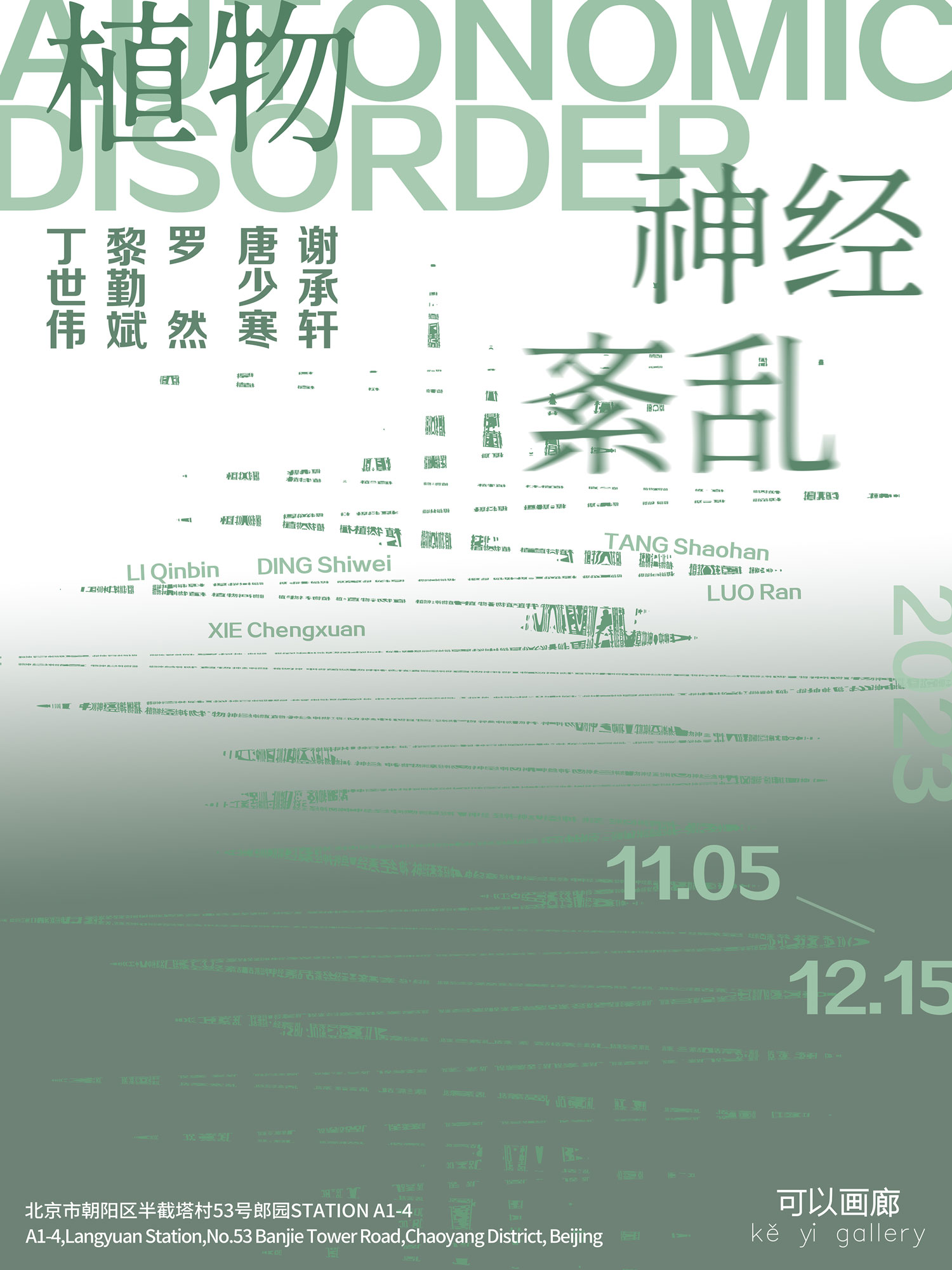展期 Period:
2023.11.5—2023.12.15
艺术家 Artist:
丁世伟 Ding Shiwei、黎勤斌 Li Qinbin、罗然 Luo Ran、唐少寒 Tang Shaohan、谢承轩 Xie Chengxuan
地点 Venue:
新闻稿 Press Release:
可以画廊欣然宣布即将带来北京空间今年的第二场群展「植物神经紊乱」,展览精选了丁世伟、黎勤斌、罗然、唐少寒、谢承轩等五位艺术家的十余件新作,其中涵盖了绘画及装置作品。
“知识变得越抽象复杂,产生疯癫的危险性就越大。”在这个媒介巨大变革的全球化浪潮中,经济与科技迅速扩张,意识形态伴随着艺术格局发生着改变,现代生活在网络媒体的充斥中加速冲击着当代年轻人的神经系统。德沃夏克在《作为精神史的美术史》中谈到:“先前,在艺术思潮受到自然科学支配的时期,人们通常将艺术的发展比做植物的生长。而今天,我们更多地是从艺术的精神内涵和形式表现之间不断冲突的角度来考察艺术的发展。”本次展览主题“植物神经紊乱”,意为自主神经功能紊乱,即由心理社会等因素诱发人体部分生理功能的失调综合症。
面对庞大冗杂的网络信息和变幻掘进的生产工具,人类以语言传递思想及其精神所在,本次展览邀请的五位艺术家皆以不同的视角折射出他们对于每个时代艺术现象的全新注解。丁世伟的作品在基于屏幕经验下的影像装置、图像视频等多种媒介形式中展开,以探寻数字媒体对个体生命经验的深度干预和参与为目的,塑造出一个富含预言性的弗兰肯斯坦式的未来物种;黎勤斌的作品在抽象的图形与制造物的形象互相置放之间,发展出一种可以被称作为“天堂制造”的情念程式,在计算机视觉算法的引入下,将形象转化为一种人造的质感,并呈现出对于形象拾捡的个人谱系;罗然的作品尝试将工具对象化,通过对工具的讨论,建立出作为幻觉空间和作为行动轨迹的模型图像,力求愈发复杂和完美结构的图像,然后在绘画中体验和分解它;唐少寒的作品将焦点放在了当下群体性的精神困境和现实语境中,尝试对这种激烈却隐秘的矛盾进行思考并整理,通过一系列改造过的图像,散状化地去构建令人匪夷所思又难以言喻的画面体验;谢承轩的作品有意识地将自我与自然结合,以绘画回应和体验心性,他将书法的精神融入到绘画语言中,在实践与理论的联系下,试图用不同的视觉语言来解构主题。
如此,在这种“既不可见又非隐藏的”“神经紊乱”似乎催促着艺术走进一个又一个没有答案的问题,正如齐泽克所言:“如果我们看待问题的方式就是问题的一部分怎么办?”
KeYi Gallery is pleased to announce the second group exhibition of the year in Beijing, titled "Autonomic Disorder." The exhibition features over ten new works by five artists, including Ding Shiwei, Li Qinbin, Luo Ran, Tang Shaohan, and Xie Chengxuan, covering a range of paintings and installations.
"As knowledge becomes more abstract and complex, the risk of becoming madness increases." In the midst of the vast wave of global media transformation, where the economy and technology are rapidly expanding, and ideologies are evolving alongside shifts in the artistic landscape, modern life is accelerating the impact on the nervous systems of contemporary youth, saturated as it is in online media. In his work "Art History as a History of Spirit," Devošek discussed, "In the past, when natural sciences dominated artistic thought, people often likened the development of art to the growth of plants. But today, we examine the development of art more from the perspective of constant conflicts between the spiritual content and formal expressions of art." The theme of this exhibition, "Autonomic Disorder," refers to autonomous nervous dysfunction, a syndrome caused by various psychological and social factors that induce a partial physiological dysfunction in the human body.
In the face of the vast and intricate web of online information and ever-evolving production tools, humans convey thoughts and their essence through language. The five artists invited to this exhibition each provide fresh interpretations of contemporary art phenomena from their distinct perspectives. Ding Shiwei's works are presented through various media forms, such as image installations and video, in the context of screen-based experiences. He aims to explore digital media's profound intervention and engagement in individual life experiences, shaping a future species reminiscent of a prophetic Frankenstein; Li Qinbin's works navigate between abstract graphics and placements of manufactured objects, developing a concept known as "paradise construction." With the introduction of computer vision algorithms, the imagery is transformed into an artificial texture, revealing a personal lineage in image selection; Luo Ran's work endeavours to objectify tools. His works construct model images that function as illusionary spaces and action trajectories by discussing tools. He strives to create increasingly complex and structurally perfect images and then experiences and deconstructs them within paintings; Tang Shaohan's work focuses on contemporary collective mental struggles and real-life contexts. He attempts to reflect on and organise this context’s intense yet hidden contradictions. Through a series of transformed images, he constructs a surreal and ineffable visual experience in a scattered manner; Xie Chengxuan's works consciously combine the self with nature, responding to and experiencing the psyche through painting. He integrates the spirit of calligraphy into the language of painting and, through the connection between practice and theory, aims to deconstruct themes using various visual languages.
In this "neurosis" that is both "invisible and non-hidden," it appears that art is being driven to confront one unanswerable question after another. As Žižek put it, "What do we do if the way we look at a problem is part of it?”

